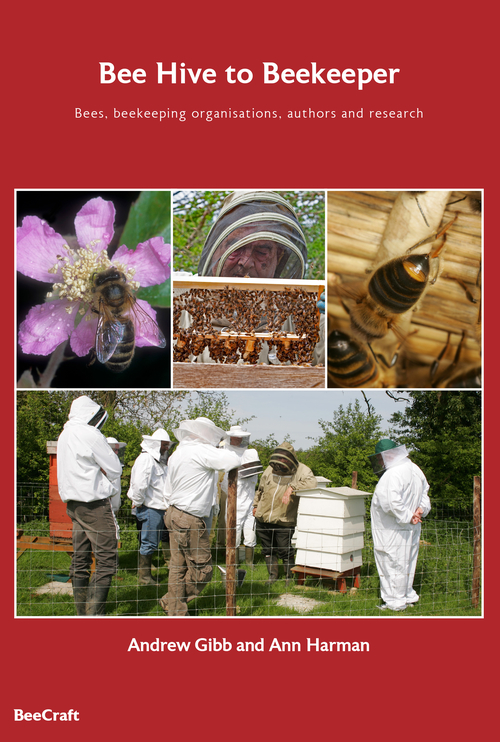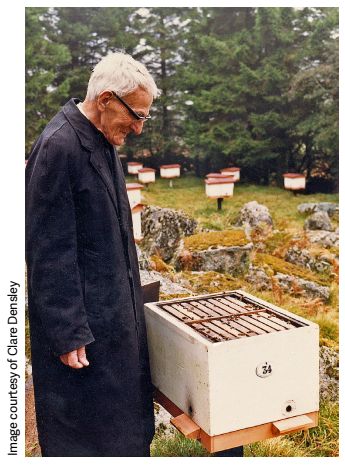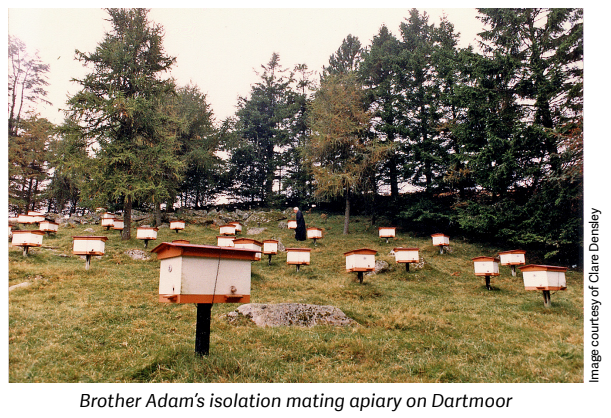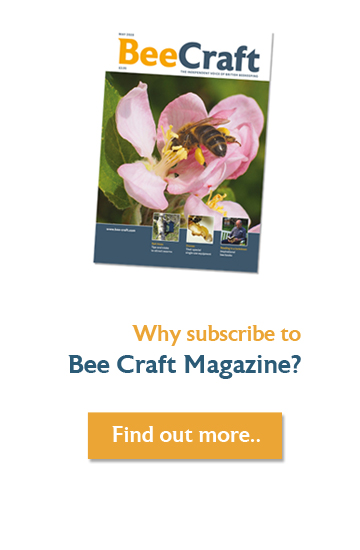1.4 INTRODUCTION OF BUCKFAST HONEY BEES
 The Buckfast is a hybrid strain of honey bee originally developed by Brother Adam (1898–1996). Born Karl Kehrle on 3 August 1898 in Mittelbiberach, Germany, Adam came to England in 1910 and, at his mother’s request, was sent to Buckfast Abbey, Devon, where most of the Benedictine brothers were German. Shortly after his arrival, he was assigned to the beekeeping department as he was not thought to be strong enough to participate in the rebuilding of the abbey. In 1919 he became head beekeeper.
The Buckfast is a hybrid strain of honey bee originally developed by Brother Adam (1898–1996). Born Karl Kehrle on 3 August 1898 in Mittelbiberach, Germany, Adam came to England in 1910 and, at his mother’s request, was sent to Buckfast Abbey, Devon, where most of the Benedictine brothers were German. Shortly after his arrival, he was assigned to the beekeeping department as he was not thought to be strong enough to participate in the rebuilding of the abbey. In 1919 he became head beekeeper.
 During the early part of the twentieth century, bees in the UK had been devastated by the Isle of Wight Disease, at that time thought to be due to the acarine or tracheal mite, Acarapis woodi. It was much later that the exact cause of the disease was clarified as probably being chronic bee paralysis virus, which was unknown at that time. Adam was inspired by the survival of the Italian (A. m. ligustica) bees crossed with the original British dark bee (A. m. mellifera) when the Isle of Wight disease reached Buckfast Abbey. He became convinced that the solution lay in the selective breeding of better bees, especially those resistant to disease.
During the early part of the twentieth century, bees in the UK had been devastated by the Isle of Wight Disease, at that time thought to be due to the acarine or tracheal mite, Acarapis woodi. It was much later that the exact cause of the disease was clarified as probably being chronic bee paralysis virus, which was unknown at that time. Adam was inspired by the survival of the Italian (A. m. ligustica) bees crossed with the original British dark bee (A. m. mellifera) when the Isle of Wight disease reached Buckfast Abbey. He became convinced that the solution lay in the selective breeding of better bees, especially those resistant to disease.
Adam made Buckfast Abbey a focus for bee breeding, first in the UKand eventually abroad. He managed around 400 colonies in the surrounding area, particularly on nearby Dartmoor, to help support the work of the abbey by selling the honey produced. The Buckfast bee was intended to be disease resistant and prolific enough to cope with the production of heather honey from the moors.
 Although his major breeding work had been completed prior to the Second World War, starting in the 1950s, Adam made several journeys to parts of Europe, the Middle East and central Africa looking for bees that might have special attributes. It was from these bees and through an intensive breeding programme that he developed the Buckfast bee.
Although his major breeding work had been completed prior to the Second World War, starting in the 1950s, Adam made several journeys to parts of Europe, the Middle East and central Africa looking for bees that might have special attributes. It was from these bees and through an intensive breeding programme that he developed the Buckfast bee.
To be able to control mating, Brother Adam started to use an isolated valley on Dartmoor as a mating apiary. With no other bees within range, he could maintain genetic integrity and develop desirable traits.
 Every new bee strain or bee race was first crossed with the existing Buckfast bees. In some cases, new desirable qualities were passed on to the next generation and the new combination was then made stable with further breeding work. Every crossing with a new race took about 10 years before the desired genes were fixed in the strain. Over 70 years, Brother Adam succeeded in developing a vigorous, healthy and fecund honey bee. In 1974, he was awarded the OBE for his work.
Every new bee strain or bee race was first crossed with the existing Buckfast bees. In some cases, new desirable qualities were passed on to the next generation and the new combination was then made stable with further breeding work. Every crossing with a new race took about 10 years before the desired genes were fixed in the strain. Over 70 years, Brother Adam succeeded in developing a vigorous, healthy and fecund honey bee. In 1974, he was awarded the OBE for his work.
In a way, Brother Adam’s work was based on the work of another monk, Gregor Mendel who, in 1856, published the primary paper outlining the fundamental laws of genetics. Mendel was also a beekeeper who experimented with different strains of bee.
Brother Adam published three books: Beekeeping at Buckfast Abbey in 1971, In Search of the Best Strains of Bees in 1966, about his travels in search of genetic building blocks, and Breeding the Honey Bee in 1987 (see chapter 4.15).
Breeding of the Buckfast bee is now undertaken by breeders throughout Europe who belong to the Federation of European Buckfast Beekeepers (GDEB). This organisation maintains a pedigree for Buckfast bees, originating from the time of Brother Adam, but much further selection has been carried out, so modern Buckfast bees may differ significantly from those originally produced by Brother Adam. Work is also carried out in many other countries around the world.
Buckfast Abbey, together with the Bee Improvement and Bee Breeders’ Association (formerly the British Isles Bee Breeders’ Association: BIBBA) have been the two main organisations in the British Isles that have made significant developments into the breeding of honey bees although they each have different objectives.
References Adam, Brother (1980). Beekeeping at Buckfast Abbey. British Bee Publications.
Adam, Brother (1985). Breeding the Honey Bee. Northern Bee Books. ISBN: 978-0-907908-32-6.
Adam, Brother (1966). In Search of the Best Strains of Bees, Walmar Verlag. ISBN: 978-0-907908-06-7.
Morse, R and Hooper, T (eds) (1985). The Illustrated Encyclopaedia of Beekeeping. Blandford Press. ISBN: 978-0-7137-1624-5.
Shimanuki, H, Flottum, K and Harman, A (eds) (2007). The ABC & XYZ of Bee Culture. AI Root Company. ISBN: 978-0-936028-22-4.
Yates, JD and Yates, BD (2018). Beekeeping Study Notes (modules 5, 6, 7 and 8), 2nd rev edn, Northern Bee Books. ISBN: 978-1-905652-72-6.




